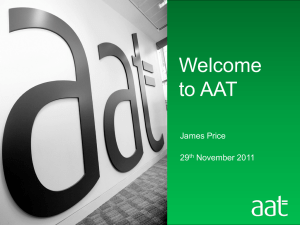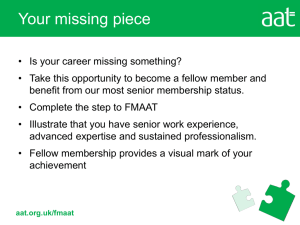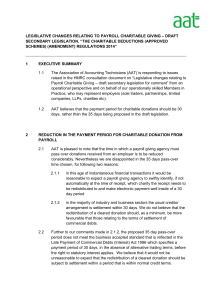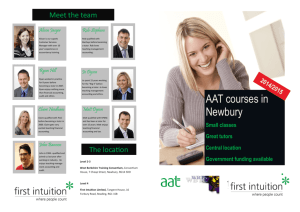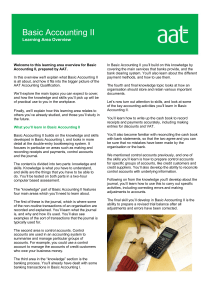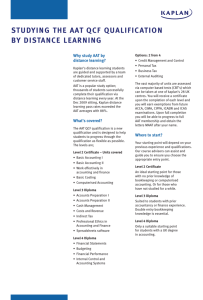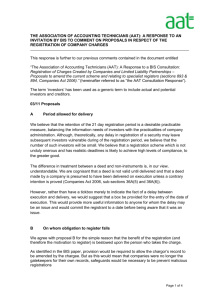Your guide to the AAT Accounting Qualification
advertisement
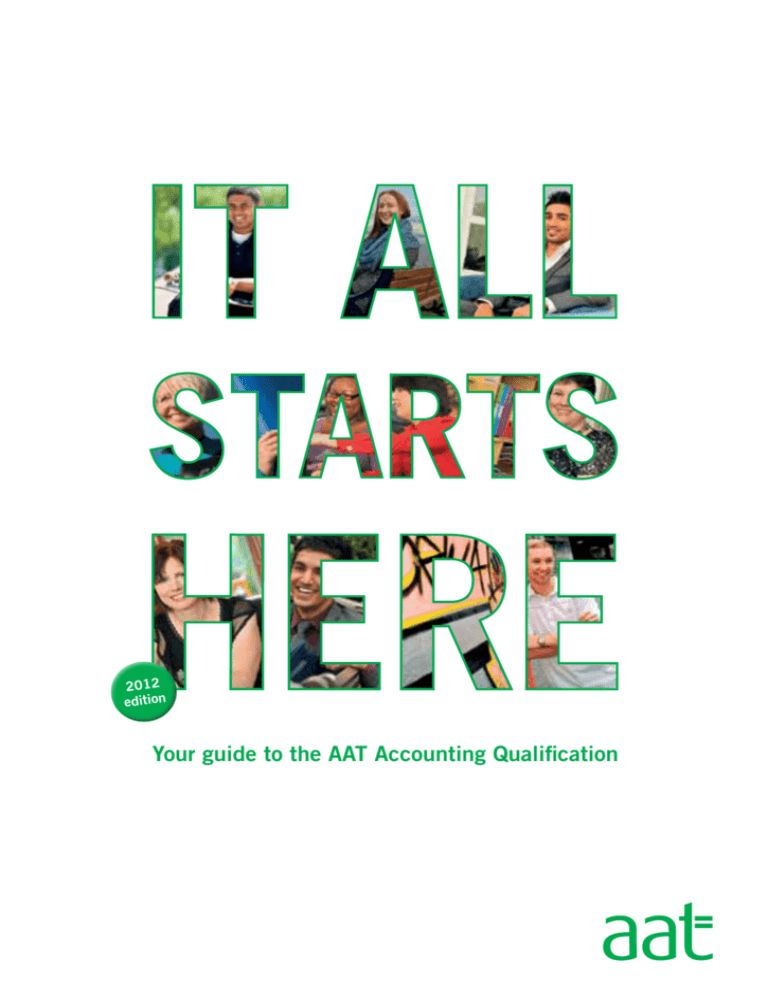
2012 edition Your guide to the AAT Accounting Qualification Five steps to AAT With AAT, you’re only a few moves from a successful career. If it’s all new to you, don’t worry; accountancy is one of the most interesting and varied professions in the world, with its challenges rewarded by a higher earning potential. And, even if you’re already working in an accountancy role, qualifying with AAT will renew your confidence to set your sights still higher. 1. Read this guide Get to know the qualification outline and take a look at some of our success stories. You’ll find more details about the AAT Accounting Qualification on page 11. 2. Select your training provider Pick and enrol with a training provider whose learning options suit you. Providers are always happy to advise you without obligation, so feel free to ask about the course before you register. 2 Above: AAT Student Recruitment team 3. Register as an AAT student member To start your training, you’ll need to register with us as an AAT student member. Join a network of 120,000 members – go online at aat.org.uk/start 4. Qualify Develop your skills and underpin them with knowledge. Two to three years of practical training and diligent study, and you’ll have achieved a recognised, professional qualification for your CV. And with full support from AAT, you’ll keep your career on the right path. 5. MAAT status Once you’ve qualified, and built up your work experience, you’ll be entitled to apply for AAT professional membership: a respected sign of accounting excellence. And, with the letters MAAT after your name, it’s a great way to stand out from the crowd. Contents 04Taking care of business – and you 05Your professional career path 07 Tried, trusted and totally respected: AAT means you’re a qualified success 08AAT student membership – we’re here to help things move along 6 09 Moving on up to MAAT 11Let’s get down to business. What about the qualification? 12What’s covered – level by level 17 How and where can you train? 10 18How long will it take to qualify? 19 Cost breakdown for your training 20 Financial support while you train 21 Where next? 22 Yes, I’m ready to apply 16 Register now online at aat.org.uk/start 3 Taking care of business – and of you The Association of Accounting Technicians (AAT) is the membership body that’s all about you: your support and training, your most promising career moves, your opportunities to succeed. AAT represents the highest standards of professionalism. So it’s not surprising there’s universal recognition of the AAT Accounting Qualification – your route to some of the most in-demand skills in the world, and a professional status you can be proud of. In just over 30 years we’ve become a membership organisation for over 120,000 ambitious accounting professionals. AAT qualified members occupy senior, well-rewarded positions with thousands of employers, from blue-chip corporate giants to public sector institutions. Vodafone, the NHS, the Metropolitan Police, KPMG and many more continue to hire AAT qualified members for their knowledge, skills, diligence and enthusiasm. Qualifying with AAT is only the start – join our 50,000-plus full and fellow members (MAATs and FMAATs) and your career prospects will gather pace. With a wealth of membership benefits as part of the package, you’re closer than ever to increased earnings, responsibility and job satisfaction. If further training or chartered status is your goal, we can help make it happen. And, because we’re recognised nationally and internationally, your career path is laid before you. In short, as a qualified and professional member of AAT, your future couldn’t be brighter. “AAT gives such a thorough background in accounting concepts. Having the qualification has given me more confidence, and I believe AAT students are more equipped for the workplace than graduates in this field.” Bhavi Bhudia MAAT Business Partner Snack Time 4 Your professional career path The term ‘accounting technician’ covers a huge range of key accounting roles. From Finance Administrator to Head of Finance, they’re all crucial to every type of business. For any accounting technician qualified with AAT, finance is second nature. This opens up huge opportunities. You could become a Senior Forensic Accountant, or find yourself dealing with tax, corporate finance, investments or restructuring at the highest levels of industry and commerce. Look at the big players in any market. It’s a safe bet that many CEOs and senior directors were trained in one or more of the many accountancy disciplines covered by AAT. From advertising to zoo keeping, beauty salon to football club, business wouldn’t be business without qualified accounting staff. • S ought after by all – from small local enterprises to the biggest multinationals. • A n exciting, exacting business discipline, full of opportunities. • P lay a key role within a large financial team – or as the single crucial expert in a small business. • W ork freelance, providing accountancy services for small businesses and other self-employed people like you. “The AAT qualification bridges the gap between technical knowledge and practical experience. It has been essential for me in securing my first finance role.” Ceris Williams AAT student member AVOW Register now online at aat.org.uk/start 5 “AAT gave me practical accountancy skills needed to develop in my role.” “I was lucky enough to start an apprenticeship with a local accounting firm. At first, I was preparing financial statements for small sole traders but have gone on to work with limited companies. I’m now at Morgan Stanley and have almost finished my AAT training. AAT has helped me develop core business skills and given me the confidence to apply this knowledge in a variety of different working environments.” Arman Hussain AAT student member Morgan Stanley 6 Tried, trusted and totally respected: AAT means you’re a qualified success Our qualification is founded on a simple rule. It’s called the real world. The AAT Accounting Qualification is based on real-world knowledge supported by in-depth expertise. You can choose how, when and where you study. Training is flexible, practical and open to everyone. And we train students across a range of ages and levels of experience. Qualifying with AAT is good news for employers too. The value of our training is so widely acknowledged that many firms actively seek AAT qualified staff. Heading for your first job, or simply seeking a change of scene? Employers recognise the value of practical accountancy training underpinned by comprehensive knowledge. Already working in accounting? Being a qualified full member of AAT is a great way to build on your skills and grow your career. We’ll support you at every turn As we want to give you the very best chance to succeed, we work closely with our approved training providers to make sure you have all the support you need while you’re training. As an AAT student member, you’ll be part of a network of like-minded individuals and we’ll provide opportunities to network and share experiences, both online and in person. With full professional membership the logical next step after qualifying, our support’s there for the long-term. Throughout your career, AAT can provide additional training and support to help you stay ahead. And you’ll be welcome to call on AAT resources whenever you need. Arman Hussain AAT student member Morgan Stanley Register now online at aat.org.uk/start 7 AAT student membership – we’re here to help move things along Before you start your training, you’ll need to become an AAT student member. It’s your introduction to a host of resources to help your studies. Job-finding and CV builder service • T ips on interviews and job searches, an interactive online CV builder plus employers’ videos. • F ind job vacancies, apprenticeships and useful career advice at our job site aat-jobs.co.uk aat.org.uk • MyAAT account: manage your AAT membership. • S tudy support and e-learning: practice assessments, interactive audio-visual tutorials and quick tests to help you progress. • L ively discussion forums: share ideas with other AAT student members. • C omprehensive archive: articles relevant to your studies. Accounting Technician magazine and e-newsletters • E very other month, you’ll receive our magazine which is packed with news and advice. You’ll also get our regular email newsletter StudentPlus. Great opportunities to network • O ur branch network activities offer support, invaluable contacts and seminars. • Over 350 events a year, at 45 UK-wide branches. Dedicated telephone helpline • O ur Membership Support team can help with membership issues on 0845 863 0801, any time between 09.00 and 17.00, Monday to Friday. Or email us at membershipsupport@aat.org.uk Exclusive discounts: AAT Additions and NUS Extra • G reat offers from AAT Additions: our exclusive membership benefits scheme with discounts on many professional, social and lifestyle items, from holidays to insurance. • N US Extra card from National Union of Students provides a range of student benefits for just £11 per year. 8 “I have used the online assessment and always read the magazine. I have also made a number of friends on the AAT Facebook page, and we keep in touch comparing notes, stories and helping each other with study tips.” Nicola Johnstone AAT student member Freeland Automotive Moving on up to MAAT Just four letters, but a wealth of opportunity. MAAT represents your professional membership of AAT. Available once you’ve qualified, AAT full membership speaks volumes and open doors. Embodied in the letters MAAT after your name, it’s proof of your authority as a finance professional. It signals that you’ve not only qualified with AAT and gained the relevant work experience, but that you’re keen to excel. Better prospects For organisations hiring the best available accounting and finance staff, MAAT is increasingly the decisive factor. Full membership boosts anticipated earnings beyond those of non-member AAT qualifieds. With more pay comes greater responsibility and job satisfaction. Long-term MAAT benefits Designed to stand you in good stead over the long term, the advantages of AAT full membership are widely acknowledged. Among the many advantages you’ll enjoy as a MAAT are: • h elp with your continuing professional development (CPD): where you’ll cultivate your hard-won skills and stay at the top of your game. • o nline services: from blogs to podcasts and dedicated e-learning resources, featuring professional speakers and key AAT members. • A AT events: including free branch and Connect events, and exclusive rates for mastercourses such as our popular Tax update series. Opportunity to run your own accountancy practice You could also join over 3,500 of our professional members and become your own boss as an AAT licensed member in practice (MIP). As a MIP you can choose: • your services, clients and hours • to become a sole trader, partner or director • to work from home, around your family or an existing job • to be self-employed part-time while working for another employer. Visit aat.org.uk/membersinpractice for more information. Register now online at aat.org.uk/start 9 “I wanted a qualification to show employers my credentials.” “I wouldn’t say I was a star pupil at school. Expelled at 16, I then became a young mum. After a series of dead end jobs, I realised I needed something more. I wanted a qualification to show employers my credentials and give my life some direction. AAT turned everything around. I’m now on the way to being fully qualified and have a great job as a finance controller. I love my job and the stability it’s brought to my life. Thanks to AAT, I can provide for my daughter and work towards a better future for her and me.” Claire Cardwell AAT student member Welcome Break Gordano 10 Let’s get down to business. What about the qualification? The AAT Accounting Qualification is divided into three levels, each providing you with a new set of skills underpinned by knowledge. Each qualification level is made up of several learning and assessment areas. At the final level, you’ll have the option to choose which areas you cover, enabling you to tailor your training. Every level is a qualification in its own right and completion of the final level leads to the full AAT Accounting Qualification. How will I be assessed? To demonstrate the skills you’ve developed during your training, you’ll be assessed using our flexible and practical computer based assessments (CBAs). Agreed with your training provider, you’ll sit assessments as and when you’re ready. Your understanding of many learning and assessment areas is measured using formal tests. These are marked automatically with provisional results available straight away. Some learning and assessment areas use other computer-administered methods, including projects, reports and workplace evidence. These are manually marked and you’ll normally have the results within six weeks. An overview of each level Level 2 or Level 5 in Scotland At Level 2* you’ll get to know finance administration, including double-entry bookkeeping, basic costing principles and purchase, sales and general ledgers. Approximately equivalent to GCSE grades A to C, Standard Grades and Intermediate 2s. Level 3 or Level 6 in Scotland At Level 3* you’ll encounter more complex financial processes, including final accounts for sole traders and partnerships, reports and returns and professional ethics. Approximately equivalent to A Levels or Scottish Highers. Level 4 or Level 8 in Scotland Finally, Level 4* covers financial team leader skills, including financial statements for limited companies, complex management accounting tasks, management skills and specialist learning areas. Approximately equivalent to the first year of an honours degree. A word about our qualification levels You might be wondering why we’ve only discussed Levels 2, 3 and 4*. In fact, Level 1 is AAT Access – a new, short course giving you the basic business and accounting skills that will start you off on the right foot. Some of our training providers offer AAT Access as a stand-alone qualification, while others include it along with your Level 2 training. Find out more at aat.org.uk/getstarted *In Scotland, Levels 2, 3 and 4 equate to Levels 5, 6 and 8. For more information, see Your guide to SCQF in Scotland on the AAT website. Register now online at aat.org.uk/start 11 Level 2 Certificate in Accounting (Level 5 in Scotland) What’s covered and is it for me? A range of basic accounting practices and techniques, from costing and double-entry bookkeeping to computerised accounting. Perfect if: you’re new to finance or you’re looking to brush up on your foundation knowledge and skills. What’s on the learning agenda? Basic accounting 1 • P rinciples and procedures related to processing business transactions, financial documents and payments for customers and suppliers. • D eveloping skills in processing ledger transactions and preparing an initial trial balance. Basic accounting 2 • M aintenance and reconciliation of a cash book by accurately entering receipts and payments, balancing off the book and reconciling with bank statements. • K nowledge and understanding of the UK banking system and related organisational activities. • P etty cash transactions and the importance of the Journal as a primary accounting record. • M aintaining control over debtors and creditors, aided by preparation and use of debtor and creditor control accounts. • N on-standard bookkeeping transactions and double-entry bookkeeping records. 12 Working effectively in accounting and finance • D eveloping transferable skills and effective working in an accounting environment. • T eamwork skills and the ability to work independently. • D emonstrating workplace-ready standards of literacy and numeracy. Basic costing • C ost recording systems within an organisation and how best to respond to requests for information relating to costs and expenditure. • R ecording and extracting information, and using a costing system to provide information for management. Computerised accounting • S electing and using computerised accounting or bookkeeping software to input and process data for orders, invoices, receipts and payments. • Preparing management and period-end reports. Additional learning and assessment area for Level 2 apprenticeship students only Professional ethics in accounting and finance • Importance of ethical duties and how to work within the code to ensure that the public can gain confidence in accounting practices or functions. • P rotecting both your and your organisation’s professional reputation and integrity. For full guidance on the content of the qualification, please speak to an AAT Approved training provider or contact us. Level 3 Diploma in Accounting (Level 6 in Scotland) What’s covered and is it for me? This second level introduces more complex accounting tasks, like maintaining cost accounting records and the preparation of reports and returns. Perfect if: you’ve completed Level 2, or you’re already at a more intermediate level and you’re looking to develop your accounting skills. What’s on the learning agenda? Cash management • P rinciples of managing cash balances and deficits within an organisation. • A dvising on options available for raising finance and on investment of surplus cash, without detriment to the cash flow of normal business activities or risk to the organisation’s ongoing liquidity. Costs and revenues • Identifying why cost accounting is an important tool for an organisation. • D ifferent approaches to cost accounting and making informed and reasoned judgements to guide management and help decision making. Indirect tax Accounts preparation 1 • Recording and accounting for non-current assets. • A dvanced bookkeeping, including final adjustments ready for preparation of financial statements. • D eveloping your understanding of accounting systems and the environment and principles under which organisations operate. Accounts preparation 2 • P reparing accounting records from incomplete information. • Preparing financial statements for sole traders. • Preparing financial statements for partnerships. • D eveloping your understanding of accounting systems and the environment and principles under which organisations operate. • U nderstanding current VAT regulations and building your knowledge of VAT registration requirements, different VAT schemes available, penalties for non-compliance and the different types of classification of supplies. • P erforming the calculations needed to complete a VAT return. • S ubmitting completed documentation in a timely manner while maintaining an effective working relationship with the relevant tax authority. Spreadsheets software • H ow to use software for recording data in rows and columns, perform calculations with numerical data and present information using charts and graphs. Professional ethics in accounting and finance • Importance of ethical duties and how to work within the code to ensure that the public can gain confidence in accounting practices or functions. • P rotecting both your and your organisation’s professional reputation and integrity. Register now online at aat.org.uk/start 13 Level 4 Diploma in Accounting (Level 8 in Scotland) What’s covered and is it for me? The final level covers higher level accounting tasks, including drafting financial statements, managing budgets and evaluating financial performance. You’ll also have the opportunity to specialise in areas from tax to auditing and credit control. Perfect if: you’ve progressed through Levels 2 and 3, or you’re at a more advanced stage in your career and you want a qualification to give you the confidence and proof that you have the skills to do the job. Once you’ve achieved this level, you’ll be the proud owner of the AAT Accounting Qualification. With proof of relevant work experience, perhaps gathered while you were training, you’ll be able to apply to become a full member of AAT and use the letters MAAT after your name. What’s on the learning agenda? Financial statements • T he external reporting environment for limited companies and groups which need to publish accounts. • P rinciples of consolidated accounts, and analysis and interpretation of financial statements. • P reparing a range of financial statements and identifying an organisation’s financial position. 14 Budgeting • H ow and why budgets are prepared, helping you prepare revenue forecasts and a range of budgets for different circumstances. • U nderstanding budgetary procedure to aid organisational planning and control. • P reparing budgets, analysing variances and making recommendations for improving organisational performance. Financial performance • M anaging and measuring financial performance; the range of techniques for analysing information on expenditure and making judgements to support decision making, planning and control by managers. • C ollecting and analysing information, monitoring performance and presenting reports to management. Internal control and accounting systems • Identifying the role of internal control within an organisation and recognising different approaches to making informed recommendations on how to implement or improve systems. • C ommunicating this to management and identifying the impact that changes would have on the system and its users. Specialist learning and assessment areas for Level 4 (or Level 8 in Scotland) – two options from the following four. Credit management and control • P rinciples of credit management in an organisation, advising on the granting of credit, setting credit limits, collection of monies owed and the likelihood of receipt of payment. • A dvising on debt management and ways to minimise risk to the organisation. Personal tax • H ow Income Tax and Capital Gains Tax is applied to income. • C alculating Income Tax liabilities and income from all sources. • A pplying relevant allowances, deductions and reliefs to prepare accurate Income Tax computations. Business tax • P reparing tax returns for sole traders, partnerships and incorporated businesses. You’ll recognise trading profits, make adjustments and apply current relevant legislation. External auditing • L egislative and professional requirements, and how to act as part of an audit team in planning and conducting an external audit. • Drafting working papers and a final audit report. • V erifying accounting records and recognising deficiencies or errors. “I started studying AAT at 18 and became a full member by 21. I gained a promotion within the company and this was all down to AAT. AAT has given me an enormous sense of achievement and respect; and has been invaluable in my working life.” Donna Culliford FMAAT Accounts Supervisor On Tap Water Treatment Register now online at aat.org.uk/start 15 “I wanted training that would give me the flexibility to work full-time.” “I first heard about AAT when studying for my A Levels. I’d always enjoyed maths so accounting seemed a good career choice. I was scared of incurring large student debt and wanted practical training that would give me the flexibility to work full-time. AAT is exactly what I needed. It helped me find a job in credit control and also an employer who would support my studies financially. Choosing AAT over university was the best decision I’ve ever made. I’ve avoided debt, gained a recognised qualification, first hand experience, and, best of all, been promised a pay rise once I’ve qualified.” Maddison Grant AAT student member O’Neill Wetsuits 16 How and where can you train? Across the UK, it’ll be with one of over 400 AAT Approved Approved training providers. All AAT training providers have to meet our stringent standards for approval, with training quality ensured by our thorough and frequent checks. You can choose from a wide variety of locations and types, from further education colleges to private training providers. Which training provider is right for me? To find a training provider in your area, call us to discuss your options on 0845 863 0802, or go to aat.org.uk/trainingproviders Once you’ve shortlisted your centres, consider these questions: • w hat type of training do they offer – full-time, part-time or distance learning? • w hich levels of the AAT qualification are taught at each centre? Call us fo advice r o n 0845 863 0 802 Flexible options for training Full-time: studying full-time at an AAT Approved training provider may suit you if you are not working full-time. Full-time AAT students often qualify sooner than part-time or home based students. Part-time: if you have a full-time job you may want to train for the qualification part-time. If you work in an accountancy or finance position, you’ll be able to practice your new skills at work, as soon as you gain them. Your work-life balance is important so we’ll provide you with some tips to help you get the most of out of your study time. Distance learning: distance learning allows you to train from home, choose where and when to study, and set your own pace. You don’t need to worry that you’ll be sent your textbooks and left on your own. Our providers offer a variety of tools to help you succeed, including online live classrooms where you can ask questions and speak to other students, online revision seminars and e-learning. With most providers, you’ll also be assigned a tutor for any questions you have. • w hat books, assessments and other items does the course fee cover? • does the course timetable fit in with my schedule? • how are assessments prepared for? Register now online at aat.org.uk/start 17 How long will it take to qualify? Flexible study options and on-demand assessments mean it’s up to you Which level should I start my training at? One of the great things about AAT qualifications is the flexibility of our training. You can study at a pace and place that suits you. It all depends on your qualifications and accounting experience. If you can show competence in some skills, you might not need to complete every learning and assessment area. Once you’ve found a provider that sounds right for you, contact a member of their staff to talk about your course options. To prepare for this meeting, complete the Skillcheck questionnaire online at aatskillcheck.org • Expect to spend around a year on each level. • If you’re a school leaver, this would probably mean three years to qualify as you’ll start at Level 2. • A ny previous accounting experience? If you’re further along with your skills, you might complete training in two years or less. • W hat if your situation changes? You might be able to take a study break. But bear in mind that if the gap exceeds three years, you may need to retake parts of the qualification. • Y ou should plan to spend three hours a week outside of class for each learning and assessment area you’re studying, then increase it in the run-up to assessments when you’re revising. • D on’t forget, you can also draw on a wealth of further AAT support. Do I need prior qualifications? All you need is an aspiration to achieve. If you do have any relevant school or college qualifications, a degree or some accounting experience, these will still be a help. You might even be able to start with AAT at a higher level. We only ask that you’re confident with numbers and that you can complete assessments and written projects in English. 18 “I chose distance learning as it was the most flexible option. I can choose how much and when I want to learn to fit around my home life.” Daniel McGuren MAAT Accounts Supervisor Message Trust Cost breakdown for your training What will my training cost? Ethel Durrant and Cathy Littler AAT student member and tutor Milton Keynes College Though it ultimately depends on how and where you study, the exact cost of training for the AAT Accounting Qualification will include: 1. Training provider fees These cover your tuition and sometimes your assessment and course materials. Since the cost of AAT training depends on the size, type and location of each centre, you’ll find big differences in fees between providers – so it really does pay to shop around. 2. AAT admission and student member fees These cover your student registration and the support you’ll have throughout your training as a student member. Being part of a membership body for accounting professionals is respected by employers, and by your colleagues. AAT admission, membership and assessment fees: Level 2 Certificate or Level 5 in Scotland Level 3 Diploma or Level 6 in Scotland Level 4 Diploma or Level 8 in Scotland Before 01.09.12 From 01.09.12 Before 01.09.12 From 01.09.12 Before 01.09.12 From 01.09.12 AAT admission fee (£)* 36 38 Annual student membership (£) 80 82 80 82 80 82 Training provider fees (£) Fees vary, so check with your chosen training provider. AAT fee per assessment (£) 33 38 40 AAT Accounting Qualification 35 36 38 *This one-off fee is also payable if you start your studies at either of the next two levels. This table assumes each level of the AAT Accounting Qualification is completed in one year. All fees correct at time of going to press – July 2012. Register now online at aat.org.uk/start 19 Financial support while you train Can I involve my employer? Where can I get financial help? If you’re working, it’s well worth telling your employer that you’re training with AAT; their support is a real boost. Because the qualification is practical in nature, your manager might be willing to help with the costs. Some pay training providers’ fees, AAT fees or for books – and sometimes all three. Your employer might also give you time off for classes or revision, and may be able to involve you in workplace projects useful to your studies. Depending on your circumstances, you might be able to get financial support from the government or other agencies. If you’re aged 16-24, for example, some courses are free. For more information about possible sources of funding, visit aat.org.uk/funding or ask your chosen training provider. “We chose AAT as it’s a great way to provide the relevant skill set for those that work in finance. Our staff have really benefited from their AAT training. It’s given them greater confidence in their abilities to progress to more complex roles and it has also created a great level of teamwork with students supporting each other. We fully fund the course and students can take study leave for revision and exam days.” Mark Baldwin Head of Payment Services BT 20 You becom can e char t much faster ered throug AAT fa h stthroug track than h univ ersity or any o qualifi ther cation . Where next? The logical next step Long after qualifying we’ll also help develop your career as an accounting professional, bringing closer those goals you’ll have worked so hard for. • F inishing training? Apply for AAT full membership and gain MAAT status; its development opportunities mean instant advantages for you. See page 9 for more benefits. • L ooking to work overseas? AAT qualifications are recognised internationally. • T hinking about continuing your studies? You might want to carry on training at university, or with a chartered accountancy body. Progression to university. AAT gives you 160 UCAS points. While the AAT Accounting Qualification is a great alternative to university, once you’ve qualified you may want to continue your training and study for a degree. On completion of Level 3 or Level 6 in Scotland, you will be accredited with 160 UCAS points. And at over 30 UK universities, the AAT qualification provides exemptions on accounting and finance-related degrees. For more information on your options after achieving the AAT qualification, visit aat.org.uk/afterqualifying Fast-track route to chartered training AAT is a fast-track, non-graduate route into chartered accountancy. In fact, it’s the only professional qualification that gives you a quicker route to chartered status with a range of bodies. All the UK chartered and certified accountancy bodies recognise the AAT Accounting Qualification and offer AAT members generous exemptions. These bodies include CIPFA, CIMA, ICAEW, ICAS and ACCA. To support you in developing your skills, we’ll reduce your full membership subscription by over 50% during your studies. So you can keep the status, support and benefits that come with professional membership while you train. “Being AAT qualified means I can be a chartered accountant within four years of starting my studies, without having to go to university.” Evie Olley MAAT Trainee Accountant Peters Elsworthy & Moore Register now online at aat.org.uk/start 21 Yes, I’m ready to apply For the best and quickest way to register as an AAT student member, please visit aat.org.uk/start If you’d prefer to register by post, please call our Student Recruitment team on 0845 863 0802*. What’s next? If you register online you’ll receive immediate email confirmation that we’ve received your application. To ensure you’re gaining the most from your membership, it’s important that you register as soon as you’ve started studying. Once registered, you’ll have an AAT student membership number. You’ll be invited to log in to your MyAAT account straight away to access support and services. Need help registering or you’ve any questions? Please call us on 0845 863 0802. Our lines are open 09.00 to 17.00, Monday to Friday. Or email train@aat.org.uk *If you’d prefer to pay by cheque or Sterling draft, contact us for a paper copy form, complete it and send it back to us with your payment to: Student Recruitment team, AAT, 140 Aldersgate Street, London EC1A 4HY. Postal applications take longer but you should get your student membership details within three weeks of us receiving your application. Is there a deadline for registering? You can register as an AAT student member at any time. But you’ll need to be a registered AAT member to sit our assessments. For more information on registering as a student member before you start training, talk to your training provider. “I’d been a full-time athlete for years but I was ready for a career change. My mum is AAT qualified and arranged some temporary accounts work for me at her organisation. It was then I realised how much I enjoyed accounting and it felt a natural choice to study AAT, a recognised qualification that is flexible to fit in with my full-time job.” Alex Greenfield AAT student member Atal Y Fro 22 My checklist Everything you need to join AAT Before you start the online registration process, make sure that you have the following to hand: Your debit/credit card or payment code from your training provider*. You’ll need to pay your AAT admission and membership fee when you join. ✔ ✔ If you’re working in accounts and would like your employer to be kept updated on your progress, you’ll need their contact details. ✔ If you’ve been declared bankrupt, have a criminal conviction or civil offence record, you’ll need to provide details about the situation when you register. Answering ‘yes’ to one of these declarations isn’t necessarily a bar to AAT membership, but we will need to make an assessment to establish if your circumstances affect your suitability to be an AAT student member. For guidance on the information you will need to provide visit aat.org.uk/declarations ✔ Your Unique Learner Number (ULN) or Scottish Candidate Number (SCN), if you have one. ✔ Where you’re going to study – these are your training provider details. *If your AAT membership fee is included in your training provider course fees, they’ll issue you with a payment code. If you haven’t got this to hand, contact your training provider before starting the registration process. AAT your professional career The equals sign is a mathematical symbol invented in 1557 by Robert Recorde to represent absolute equality and is still used by accountants worldwide today. It’s also part of the AAT brand because it symbolises the equality of partnerships we strive for, in helping and supporting everyone we come into contact with. Register now online at aat.org.uk/start 23 Any questions? If you’d like to know more about AAT and our qualifications, please get in touch with us. Call us on 0845 863 0802, lines are open 09.00 to 17.00 Monday to Friday. Alternatively, email us at start@aat.org.uk or visit aat.org.uk /start Association of Accounting Technicians 140 Aldersgate Street London EC1A 4HY Registered charity no. 1050724 21210712 – 50,000 Front cover features AAT students and members: Shiril Patel, Claire Cardwell, Waqas Sagar MAAT, Maddison Grant, Ethel Durrant with AAT tutor Cathy Littler, Anna Mattocks MAAT, Donna Culliford FMAAT, Arman Hussain and Lewis Camello.
